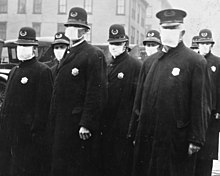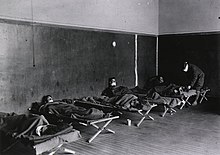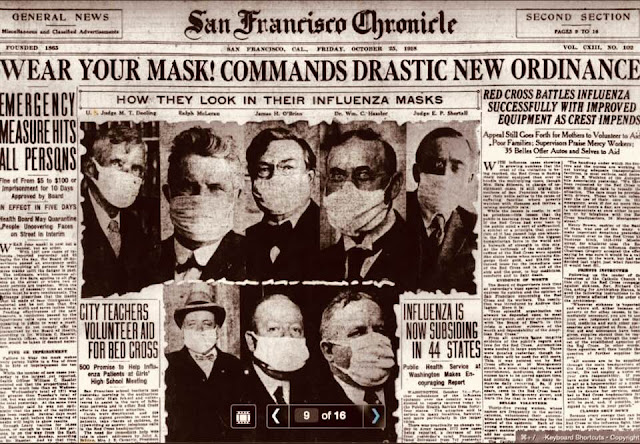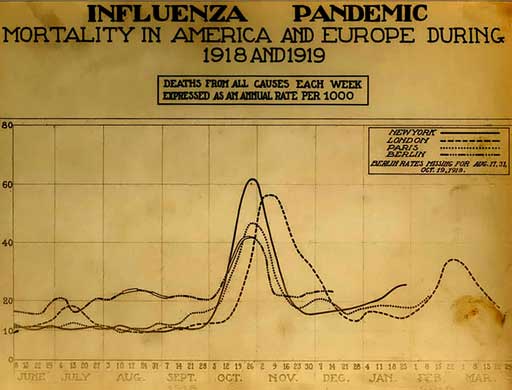The first observations of illness and mortality were documented in the United States (in Fort Riley, Haskell County, Kansas as well as in New York City), France (Brest), Germany and the United Kingdom. To maintain morale, World War I censors minimized these early reports. Newspapers were free to report the epidemic's effects in neutral Spain, such as the grave illness of King Alfonso XIII, and these stories created a false impression of Spain as especially hard hit. This gave rise to the name "Spanish" flu. Historical and epidemiological data are inadequate to identify with certainty the pandemic's geographic origin, with varying views as to its location.
Most influenza outbreaks disproportionately kill the very young and the very old, with a higher survival rate for those in between, but the Spanish flu pandemic resulted in a higher-than-expected mortality rate for young adults.[6] Scientists offer several possible explanations for the high mortality rate of the 1918 influenza pandemic. Some analyses have shown the virus to be particularly deadly because it triggers a cytokine storm, which ravages the stronger immune system of young adults.[7] In contrast, a 2007 analysis of medical journals from the period of the pandemic found that the viral infection was no more aggressive than previous influenza strains.[8][9] Instead, malnourishment, overcrowded medical camps and hospitals, and poor hygiene, all exacerbated by the recent war, promoted bacterial superinfection. This superinfection killed most of the victims, typically after a somewhat prolonged death bed.[10][11]
The 1918 Spanish flu was the first of two pandemics caused by H1N1 influenza A virus; the second was the 2009 swine flu pandemic.[12]
First wave of early 1918
The pandemic is conventionally marked as having begun on 4 March 1918 with the recording of the case of Albert Gitchell, an army cook at Camp Funston in Kansas, United States, despite there likely having been cases before him.[25] The disease had been observed in Haskell County in January 1918, prompting local doctor Loring Miner to warn the US Public Health Service's academic journal.[26] Within days, 522 men at the camp had reported sick.[27] By 11 March 1918, the virus had reached Queens, New York.[28] Failure to take preventive measures in March/April was later criticized.[29]
As the US had entered World War I, the disease quickly spread from Camp Funston, a major training ground for troops of the American Expeditionary Forces, to other US Army camps and Europe, becoming an epidemic in the Midwest, East Coast, and French ports by April 1918, and reaching the Western Front by the middle of the month.[25] It then quickly spread to the rest of France, Great Britain, Italy, and Spain and in May reached Breslau and Odessa.[25] After the signing of the Treaty of Brest-Litovsk, Germany started releasing Russian prisoners of war, who then brought the disease to their country.[30] It reached North Africa, India, and Japan in May, and soon after had likely gone around the world as there had been recorded cases in Southeast Asia in April.[31] In June an outbreak was reported in China.[32] After reaching Australia in July, the wave started to recede.[31]
The first wave of the flu lasted from the first quarter of 1918 and was relatively mild.[33] Mortality rates were not appreciably above normal;[34] in the United States ~75,000 flu-related deaths were reported in the first six months of 1918, compared to ~63,000 deaths during the same time period in 1915.[35] In Madrid, Spain, fewer than 1,000 people died from influenza between May and June 1918.[36] There were no reported quarantines during the first quarter of 1918. However, the first wave caused a significant disruption in the military operations of World War I, with three-quarters of French troops, half the British forces, and over 900,000 German soldiers sick.[37]

Seattle police wearing masks in December 1918
The second wave began in the second half of August, probably spreading to Boston and Freetown, Sierra Leone, by ships from Brest, where it had likely arrived with American troops or French recruits for naval training.[37]
From Europe, the second wave swept through Russia in a southwest–northeast diagonal front, as well as being brought to Arkhangelsk by the North Russia intervention, and then spread throughout Asia following the Russian Civil War and the Trans-Siberian railway, reaching Iran (where it spread through the holy city of Mashhad), and then later India in September, as well as China and Japan in October.[43]

American Expeditionary Force victims of the Spanish flu at U.S. Army Camp Hospital no. 45 in Aix-les-Bains, France, in 1918
Third wave of 1919
"In January 1919, a third wave of the Spanish Flu hit Australia, where it killed 12,000 following the lifting of a maritime quarantine"
Fourth wave of 1920
In the spring 1920, a fourth wave occurred in isolated areas including New York City,[51] Switzerland, Scandinavia,[54] and some South American islands.[55] New York City alone reported 6,374 deaths between December 1919 and April 1920, almost twice the number of the first wave in spring 1918.[51] Other U.S. cities including Detroit, Milwaukee, Kansas City, Minneapolis and St. Louis were hit particularly hard, with death rates higher than all of 1918.[56] Peru experienced a late wave in early 1920, and Japan had one from late 1919 to 1920, with the last cases in March.[57] In Europe, five countries (Spain, Denmark, Finland, Germany and Switzerland) recorded a late peak between January–April 1920.[54]

American Red Cross nurses tend to flu patients in temporary wards set up inside Oakland Municipal Auditorium, 1918.
Potential origins
Despite its name, historical and epidemiological data cannot identify the geographic origin of the Spanish flu.[2]
A 2009 study in Influenza and Other Respiratory Viruses found that Spanish flu mortality simultaneously peaked within the two-month period of October and November 1918 in all fourteen European countries analyzed, which is inconsistent with the pattern that researchers would expect if the virus had originated somewhere in Europe and then spread outwards.[66]
China
In 1993, Claude Hannoun, the leading expert on the Spanish flu at the Pasteur Institute, asserted
A report published in 2016 in the Journal of the Chinese Medical Association found no evidence that the 1918 virus was imported to Europe via Chinese and Southeast Asian soldiers and workers and instead found evidence of its circulation in Europe before the pandemic.[64] The 2016 study suggested that the low flu mortality rate (an estimated one in a thousand) found among the Chinese and Southeast Asian workers in Europe meant that the deadly 1918 influenza pandemic could not have originated from those workers.[64] Further evidence against the disease being spread by Chinese workers was that workers entered Europe through other routes that did not result in a detectable spread, making them unlikely to have been the original hosts.[59]
Epidemiology and pathology
Transmission and mutation

As U.S. troops deployed en masse for the war effort in Europe, they carried the Spanish flu with them.
The basic reproduction number of the virus was between 2 and 3.[77] The close quarters and massive troop movements of World War I hastened the pandemic, and probably both increased transmission and augmented mutation. The war may also have reduced people's resistance to the virus. Some speculate the soldiers' immune systems were weakened by malnourishment, as well as the stresses of combat and chemical attacks, increasing their susceptibility.[78][79] A large factor in the worldwide occurrence of the flu was increased travel.
The severity of the second wave has been attributed to the circumstances of the First World War.[81] In civilian life, natural selection favors a mild strain.
Signs and symptoms

US Army symptomology of the flu
The majority of the infected experienced only the typical flu symptoms of sore throat, headache, and fever, especially during the first wave.[85]
The majority of deaths were from bacterial pneumonia,[88][89][90] a common secondary infection associated with influenza. This pneumonia was itself caused by common upper respiratory-tract bacteria, which were able to get into the lungs via the damaged bronchial tubes of the victims.[91] The virus also killed people directly by causing massive hemorrhages and edema in the lungs.[92] Modern analysis has shown the virus to be particularly deadly because it triggers a cytokine storm (overreaction of the body's immune system).[7] One group of researchers recovered the virus from the bodies of frozen victims and transfected animals with it. The animals suffered rapidly progressive respiratory failure and death through a cytokine storm. The strong immune reactions of young adults were postulated to have ravaged the body, whereas the weaker immune reactions of children and middle-aged adults resulted in fewer deaths among those groups.[93][94]
Misdiagnosis
Because the virus that caused the disease was too small to be seen under a microscope at the time, there were problems with correctly diagnosing it.[95] The bacterium Haemophilus influenzae was instead mistakenly thought to be the cause, as it was big enough to be seen and was present in many, though not all, patients.[95] For this reason, a vaccine that was used against that bacillus did not make an infection rarer but did decrease the death rate.[96]
During the deadly second wave there were also fears that it was in fact plague, dengue fever, or cholera.[97] Another common misdiagnosis was typhus, which was common in circumstances of social upheaval, and was therefore also affecting Russia in the aftermath of the October Revolution.[97] In Chile, the view of the country's elite was that the nation was in severe decline, and therefore the assumption of doctors was that the disease was typhus caused by poor hygiene, and not an infectious one, causing a mismanaged response which did not ban mass gatherings.[97]
Respo BPM so it's a definite for me started in March its peak in October it's amazing how similar things are and what they do says here in deeper in the first stage is now a prior meeting killed old people and sick people in the second stage in primary the job, I can't stop Carmen think what and by the way by the way one word comparison they believe it started in China and China had the one of the least amount of deaths from just weird you three years ago hundred to your nses
























No comments:
Post a Comment